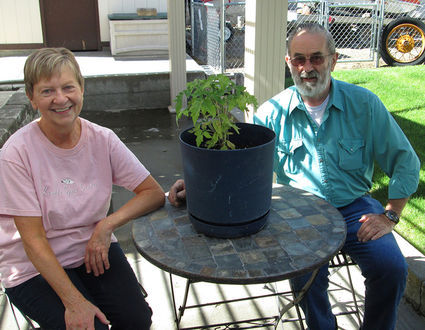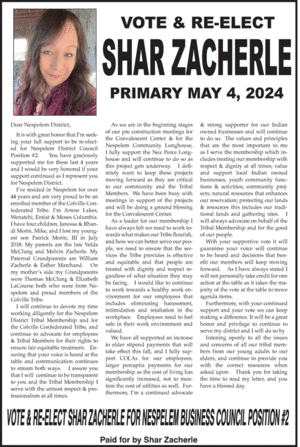Space tomatoes still floating around
Last updated 6/12/2013 at 9:51am

Jerry Beierman, left, and Nancy Carlson discuss their successes in raising tomatoes from the space tomato seeds acquired through special arrangement with NASA in the 1990s. The plant before them is from seeds from 2006 tomatoes descended from the special space seeds. — Roger S. Lucas photo
Those tomato seeds that went into space back in the 1990s are still working their wonders here in the coulee.
Nancy Carlson, teacher, now retired, obtained seeds from NASA and used them as a science project for fourth and fifth graders.
It was a perfect opportunity to not only watch the seeds grow, but a chance to plant science seeds of a different nature along the way.
While Carlson didn’t note any difference between the tomato seeds that gone into space and ordinary tomato seeds and their ultimate plants, it was a great experiment.
She grew some of the tomato plants, but also relied on Jerry Beierman, Grand Coulee’s “green thumb,” to assist her. Jerry had a more formal garden than she had, so he grew some of the space seed plants, and many of her fourth- and fifth-graders trekked up to Jerry’s garden to check on the plants.
Out of this, a special relationship grew between Carlson, her students, and NASA, and each year she took her classes to special space-related activities in Seattle.
On July 4, 2006, the Park Seed Company and NASA started the “Seeds in Space” program, which gave children all over the world the opportunity for hands-on science experience.
The first such venture had been in 1983, when some 25 pounds of various fruit and vegetable seeds went into space. In the various NASA programs some 132,000 experiment kits have been sent to teachers around the world.
If there are future scientists from the local school district, they may have found their science roots in tomato plants that came from space seeds.
Currently, Carlson has three plants growing in pots, about eight inches tall, with the prospects of producing another round of space tomatoes. So another generation descended of the space seed tomatoes are on the grow, both in Nancy’s garden and in Jerry’s garden.
The seeds had originally been scheduled to spend four years in space, but actually were up there six years, Carlson said.
While she and her students didn’t notice any difference between tomato seeds that had gone into space and those that had not, the process afforded her classes the opportunity to learn just how science experiments are done.
“Someone came up with the idea of radiation, so I asked the permission of parents to allow students to taste the space tomatoes, and most said OK,” Carlson said.
As part of the process, kids kept records and made reports on the space tomatoes, she explained.
One drawback to the experiment was that students got started with it in the spring, but missed out on summer growth, only to return in the fall and get re-acquainted with the process.
But the kids got to go on trips for NASA-related activity, and the program generally gave science a boost in the lower grades.
Carlson completed 33 years teaching in the Grand Coulee Dam School District, shared a year’s teaching with teacher Marsha Fields and then taught as a substitute for six more years. That’s 40 years of teaching, but she’s still growing tomatoes.
The plants descended from those original seeds are still turning out large, red and ripe tomatoes.





Reader Comments(0)